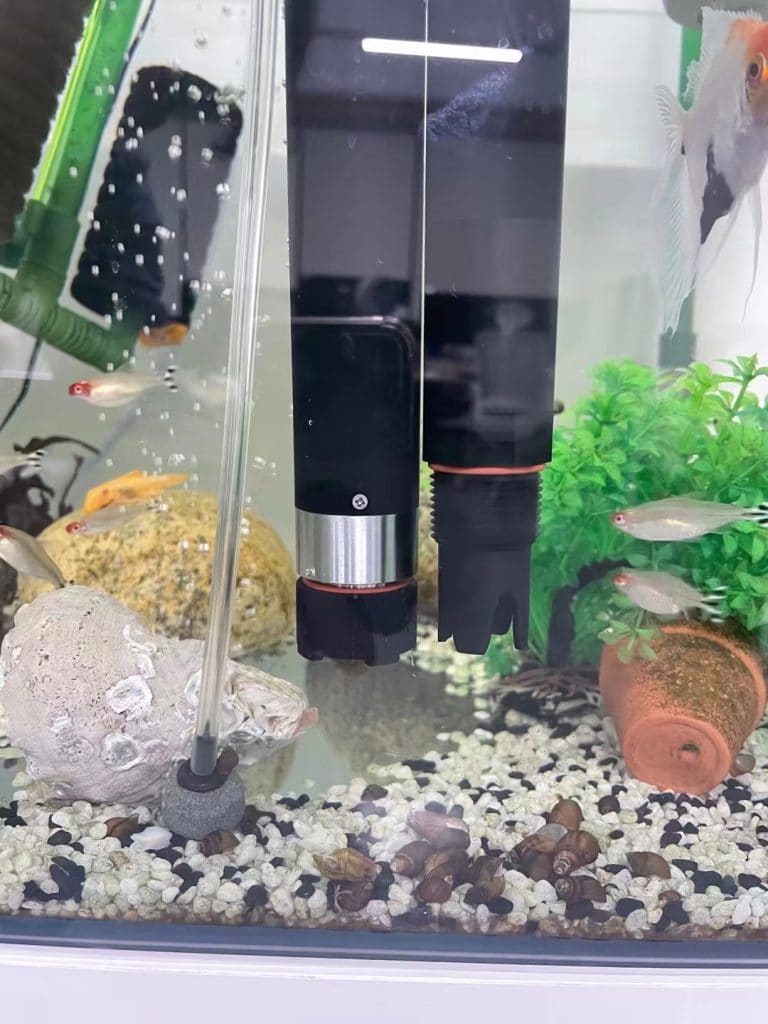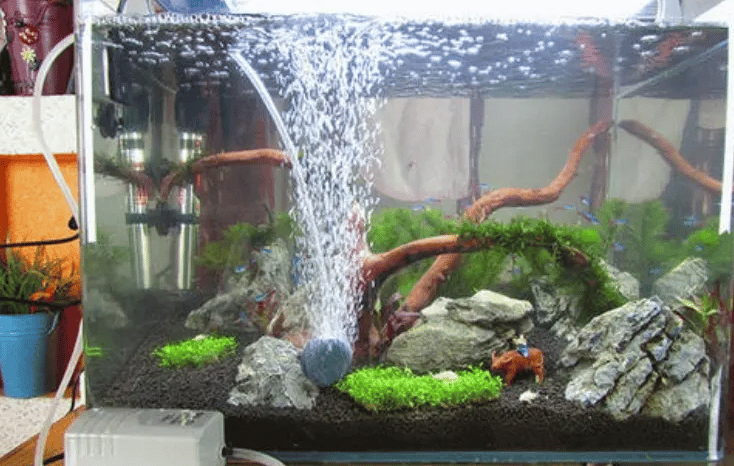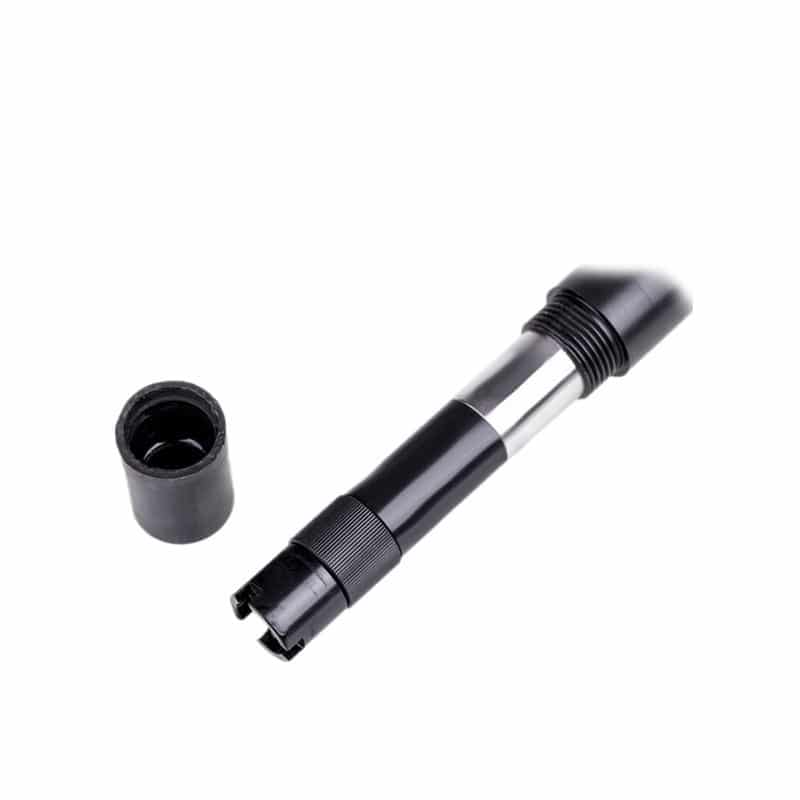The fastest way to add oxygen (O2) levels in your aquarium is to increase water movement as it allows more O2 to dissolve and release carbon dioxide (CO2). This can easily be done using an air pump, or you can do a large water change, manually agitate the water or place a fan near the aquarium.
Oxygen, especially dissolved oxygen (DO), is one of the most important indicators of water quality, as it is vital to the survival of fish and other aquatic organisms.
When DO levels drop too low, aquatic life will not survive. Therefore, if your tank is ever depleted of oxygen, it is vital to increase the oxygen level quickly.
Where do fish get their oxygen from in the tank?
Did you know that the oxygen your fish breathe in the tank does not come directly from the water?
The primary supply of oxygen (O2) in a fish tank comes from the surrounding air. This is because the oxygen naturally present in the water is inseparable, so your fish cannot use it by removing oxygen atoms from the hydrogen.
Instead, your fish depend on the gas exchange that occurs at the water surface. The carbon dioxide (CO2) in the aquarium water is exchanged with the O2 in the surrounding air.
Oxygen is also dissolved into the aquarium water through increased aeration (water movement) and photosynthesis of living plants.

How much oxygen do the fish in my aquarium need?
Oxygen requirements vary from fish to fish, however, it is recommended that your aquarium water has an oxygen saturation of 80-110% and a dissolved oxygen level of 6-8 mg/l.
Oversaturation in the aquarium (any >115%) should be avoided, too much oxygen in the tank can be harmful to the fish as it is one of the causes of air bubble disease in fish.
What causes reef tank hypoxia?
- Over-stocking: Too many fish can lead to a lack of oxygen.
- Elevated water temperature: warmer water cannot hold as much oxygen as cold water can.
- Low water flow: With no waves, enough water flow is needed to help oxygenate/ aerate the tank.
- Excessive waste buildup: Too much stock, too much feeding, and poor tank maintenance and cleaning can lead to increased ammonia and phosphate levels, which can lower oxygen levels.
- Low light conditions: If your tank is underlit and has live plants, your plants will begin to use the O2 in the water instead of CO2, so the plants will release CO2 instead of O2 into the water.
- Use of certain chemicals and medications: Certain products can deplete oxygen.
Symptoms of low oxygen levels in fish tanks
When O2 levels drop too low, no alarm bells will go off to notify you. Other than measuring O2 levels with an oxygen sensor, the only indication of low O2 levels in your tank is the behavior of your fish.
So, what should you look for in your fish?
- Labored breathing
- Rapid gill movement
- Gasping for air at the surface
If you notice any of these symptoms, be sure to measure the amount of oxygen in your tank immediately using a dissolved oxygen meter/sensor. A description of dissolved oxygen can be found here.
Ways to add oxygen to a fish tank
Pouring water from a height
The easiest way to add oxygen to your aquarium and help aerate the water is to slowly pour water from a high place.
Take a small container and fill it with some aquarium water. Gently pour the water into the tank from a height to create movement.

Stir the water manually
Another great way to increase oxygen levels is to stir the water manually. This forces movement within the tank and increases aeration.
Large water changes
Water changes of up to 50% will help deliver large amounts of oxygenated water into your tank

Add ice and use fans
If your tank has low oxygen levels due to elevated temperatures, adding ice will help cool the water. When adding ice cubes to your aquarium, be sure to keep them in a sealed bag so they don’t melt into the aquarium water, which can cause water parameters to fluctuate.
Placing a fan near the top of the aquarium will also help cool the water and it will create ripples on the surface that will increase the flow of water. The movement of the water will help to oxidize the surface water.
If you are performing a water change or blowing a fan to increase O2 levels, remember to use a temperature sensor to monitor temperature levels.
Use a battery-powered air pump
Power outages often occur, especially if you live in a storm-prone area. Unless you have purchased a home generator, if the power goes out, any electricity connected to the tank will also go out. If a power outage occurs, a battery powered air pump is a good way to keep the water flowing in your tank.
Long term methods to increase tank oxygen
The above methods of increasing tank O2 are very useful in an emergency situation, however, to prevent a recurrence of low O2 levels, we have some more permanent solutions to deal with O2 depletion.
Back hanging (HOB) filters
Back hung or HOB filters are the most common and widely used aquarium filters. Not only are they a great way to increase the oxygen level in your tank, but they are also very small and easy to install.
The filtered water is released from the HOB filter, aerating the water and distributing it evenly throughout the aquarium.

Spray bar
If you have a canister filter, you probably already have your hands on a spray bar, as almost all canister filters have them. So if your O2 level suddenly drops and you didn’t know you had it, now is a good time to use it. If your canister filter doesn’t come with one, don’t worry because you can easily purchase them online.
Spray bars work by distributing filtered water around the entire tank, therefore, increasing the O2 level in the water and preventing O2 from dropping.
Air pump
As the name suggests, air pumps are designed to pump air (O2) into your aquarium. Air pumps use air stones to collect and release oxygen from the aquarium water, making it a straightforward way to increase oxygen in your tank.

Apure dissolved oxygen sensor
Summary
Pouring water from high places, manually stirring the water, or performing large water changes are some quick ways to increase oxygen in your tank. These methods allow more oxygen to dissolve in the water and release carbon dioxide.
More permanent methods, such as using spray bars, HOB filters and air pumps, should prevent oxygen levels from dropping again.
If you have any questions about the best dissolved oxygen (DO) sensor for your testing needs, please feel free to contact Apure’s support team and we are always happy to help!
Extended reading:
Why is water quality important?
What is residual chlorine?
Solution of water pollution
What is ORP?


